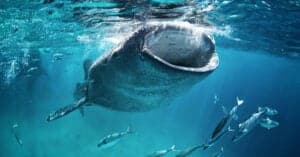Mystic Aquarium, in Mystic, Connecticut, U.S., boasts thousands of marine animals from all over the world. They also display birds, reptiles, amphibians, insects, and arachnids. Not only does Mystic Aquarium provide amazing animals to see, but they also offer animal encounters, behind-the-scenes tours, and birthday parties. The list of incredible up-close experiences includes seals, sea lions, penguins, reptiles, rays, and even jellyfish.
To top it all off, the aquarium participates in many research and conservation efforts to help protect marine wildlife. Mystic Aquarium is partnered with the Association of Zoos and Aquariums (AZA) Saving Animals From Extinction (SAFE) program to help spread the word. They also actively participate in the preservation of threatened and endangered species. In fact, the aquarium is a part of several Species Survival Plans: African penguins, coral reefs, sea turtles, sharks, and rays.
Best Time to Visit Mystic Aquarium
Mystic Aquarium has many fantastic animals to see! Usually open from 10 am to 4 pm daily, plan-ahead pricing allows you to get tickets for the best price even months before your visit. The lowest ticket prices appear to be $29 per adult on Wednesdays in January. The off-season (based on ticket pricing) is between October and April, whereas visiting during the warmer months is more expensive and much more crowded. We recommend starting your visit when the aquarium opens on an off-season weekday so you have plenty of time to see all the animals and exhibits. Getting there early also provides the best chance to beat the crowd and get the best views! The website recommends purchasing tickets ahead of time, as they’re often limited in availability and sell out quickly.
10 Coolest Animals to See at Mystic Aquarium
With thousands of animals to see, which ones should you make sure to check out at Mystic Aquarium? We’ve compiled a list of the top 10 coolest animals to visit while you’re there!
#1 Northern Fur Seals
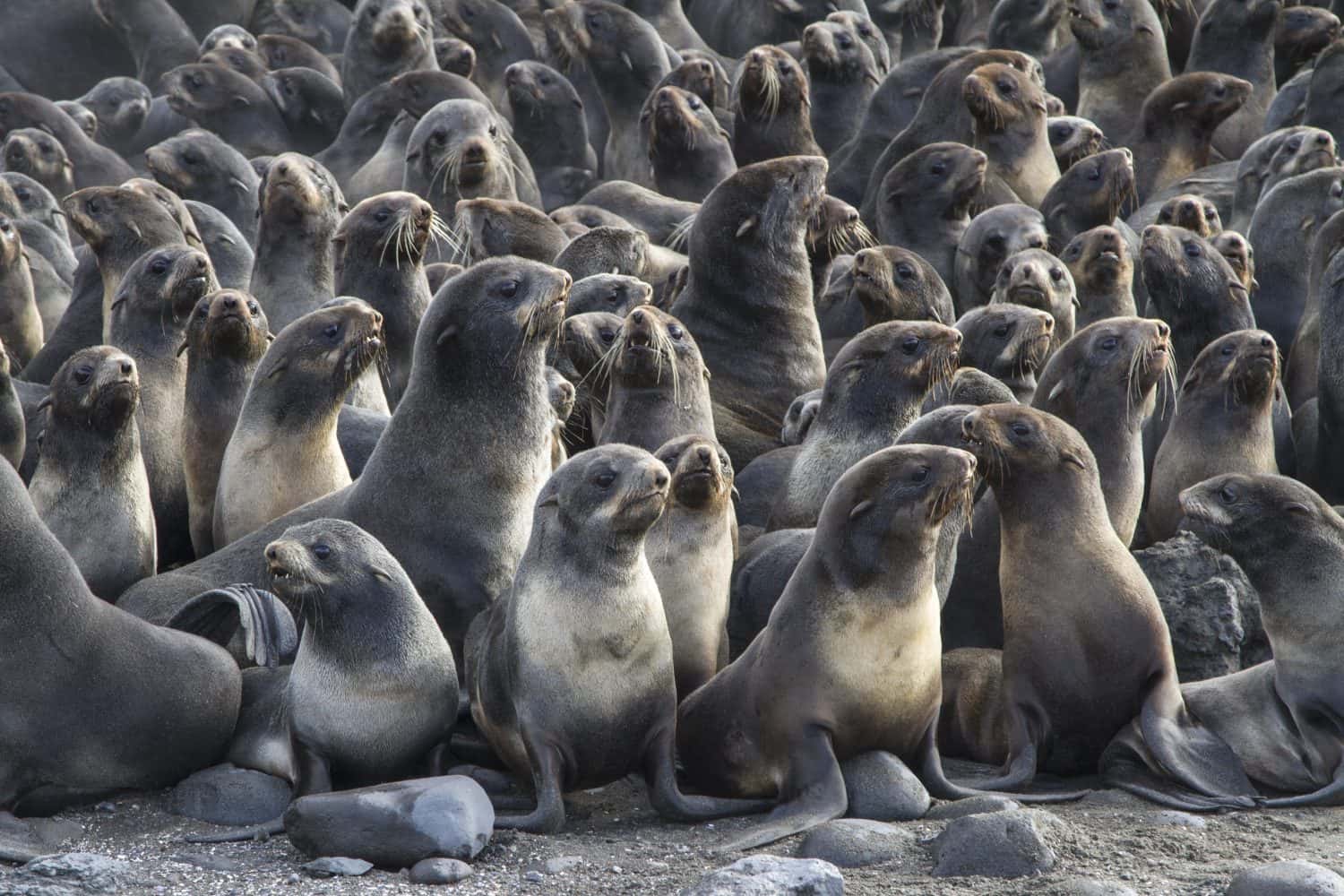
More than 1.1 million northern fur seals live across our planet today.
©Tarpan/Shutterstock.com
Northern fur seals normally live in the eastern part of the North Pacific Ocean, the Bearing Sea, off the coast of the Pribilof Islands, and in the Okhotsk Seas. They prefer the open ocean most of the time but return to land for rest, molting, and breeding. They eat a wide variety of fish and squid, sometimes diving up to 800 feet down to find a meal. Males grow up to 7 feet long and weigh up to 600 pounds! Females are much smaller at about 5 feet long and 140 pounds.
Highly prized for their dense fur coats, this species finds itself listed as vulnerable on the International Union for Conservation of Nature (IUCN) Red List of Threatened Species. Mystic Aquarium helps these animals by allowing their seals to be ambassadors to assist the National Oceanic and Atmospheric Administration (NOAA) in developing a new way to track and survey wild seals.
#2 Harbor Seals
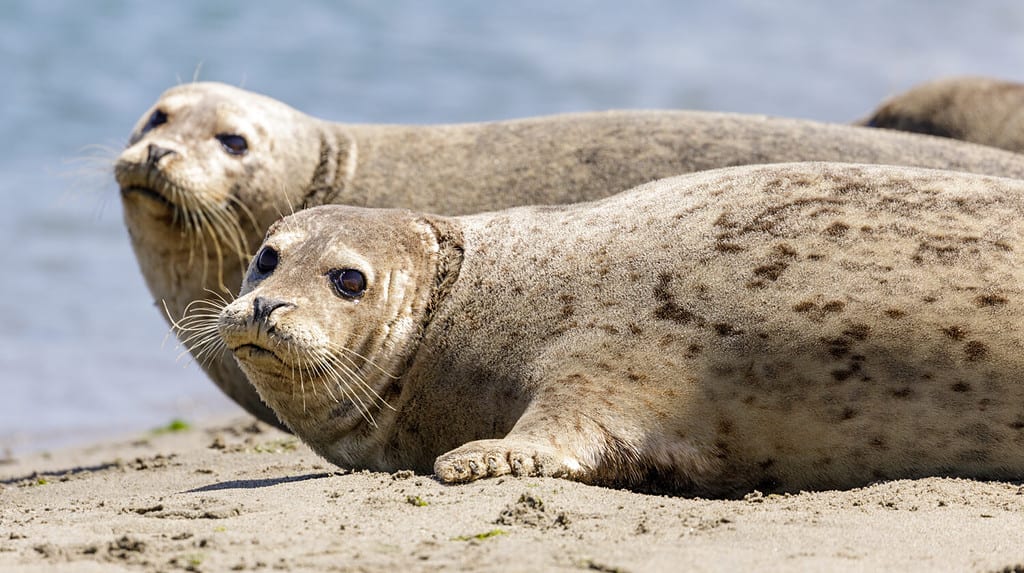
Harbor seals live in saltwater most of the time but travel up rivers in search of food.
©yhelfman/Shutterstock.com
Harbor seals naturally live around the Northern coasts of North America, Europe, and Asia. They also inhabit much of the U.S. eastern and western coastlines. Much smaller than their fur seal cousins, harbor seals only grow up to 6 feet long and a maximum of 285 pounds. Their primary prey items include fish, shellfish, and crustaceans. Harbor seals spend their time along the coast hanging out on rocks, reefs, beaches, floating ice, or docks and boat ramps when they’re not actively hunting. Interestingly, they live most of their lives in saltwater but will travel several hundred miles upriver in search of food.
Mystic Aquarium helps promote environmental enrichment for these animals by cycling them through different habitats regularly. Harbor seals are also on ICUN’s Red List as vulnerable.
#3 Spotted Seals

Spotted seals remain very wary of humans, so we don’t know a lot about them.
©Valerijs Novickis/Shutterstock.com
The smallest seal species among the animals at Mystic Aquarium is the spotted seal. Averaging about 5 feet long and 140-250 pounds, they are the only true seals that form family units. A male and female mating pair team up to protect their singular newborn pup while it grows until the next breeding season. This behavior is unusual among seals, as most species are polygamous (breeding with more than one mate).
Spotted seals spend most of their time in the frigid waters off the eastern coast of North America and the western coasts of China and Russia. They overwinter in the Bering Sea. These seals eat mostly fish with the occasional squid, octopus, or crustacean. There’s not a lot of information about spotted seals and their activities in the wild because they are very timid creatures and disappear under the water as soon as something spooks them. ICUN’s Red List lists them as vulnerable, also.
#4 California Sea Lions: Most Fun Animal at Mystic Aquarium
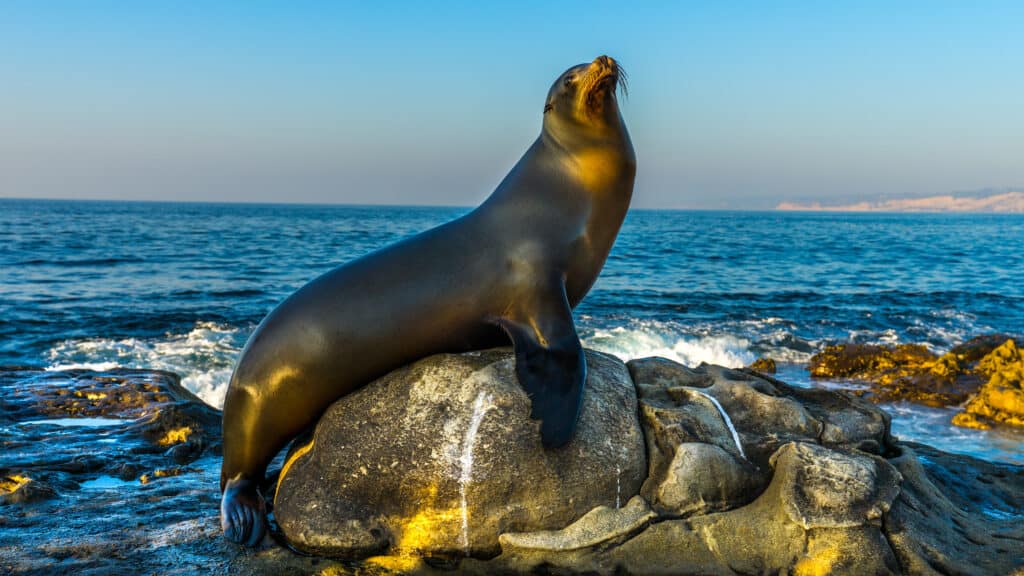
Likely the most well-known sea
lion
species, the California sea lion grows up to 700 pounds!
©Daniel Avram/Shutterstock.com
California seal lions roam the waters along the North American west coast from Baja, California to Vancouver, British Columbia. The large males reach up to 8 feet long and 770 pounds, while females average 175-220 pounds and 6 feet in length. Octopus, squid, and fish make up the majority of their diet in the wild.
These sea lions communicate with one another through loud barking and smell. A mother can tell her baby apart from others in a massive group (colony) by the sound of its bark and its unique scent. Females with pups must leave them on the beach for days at a time in search of food until the babies learn to swim.
Second only to the South American sea lion in worldwide population, the ICUN lists California sea lions as the least concern. They live about 20-30 years on average. One male breeds with as many as 14 females at a time. He aggressively defends his harem (group of females) and territory from competing males.
Mystic Aquarium proudly shows off these animals at the Foxwood Marine Theater. The underwater viewing area allows visitors to see the amazing sea lions swim up to 30 mph (mile per hour)! They also perform tricks and tasks in front of visitors. Don’t think these shows are just for you, though — all the behaviors the seal lions are taught help their keepers make sure they’re in tip-top shape. This training is called “voluntary participation” and is used in zoos and aquariums worldwide.
#5 Stellar Sea Lions

Stellar Sea Lion males grow up to 2,500 pounds and fight one another for the right to breed.
©Alexander Machulskiy/Shutterstock.com
Next comes Mystic Aquarium’s second-largest resident animal. Stellar sea lion males grow up to 11 feet long and weigh as much as 2,500 pounds! Females reach up to 9.5 feet long and about 800 pounds. In the wild, they prefer the cold waters of the North Pacific Ocean and the coasts of California and Alaska. These massive sea lions feed on fish including cod and salmon, along with squid. Amazingly, these sea lions are capable of climbing rocks! ICUN lists them as near threatened. Mystic Aquarium is one of only two U.S. facilities housing this species.
#6 Beluga Whales: Rare Animal to See in Captivity at Mystic Aquarium
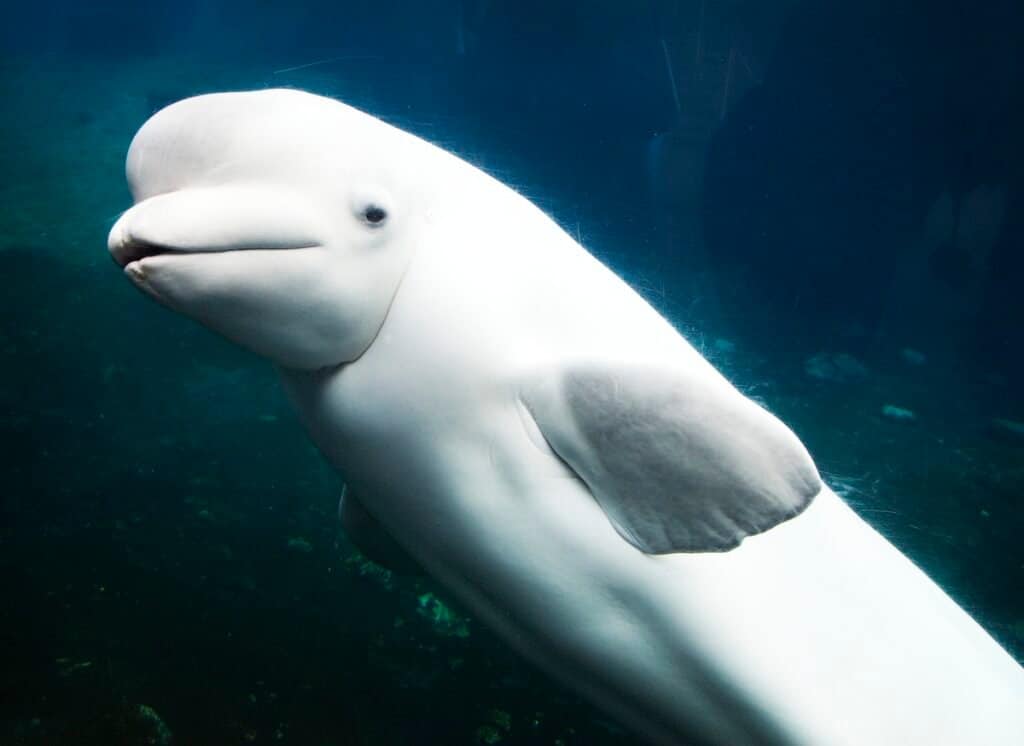
Mystic Aquarium has an outdoor beluga whale display.
©Carol M Highsmith / CC0 1.0, Rawpixel – License
The unique-looking beluga whale ranges from 12 to 15 feet in length and 1,600 to 2,500 pounds. Their wild habitat includes areas of Russia, Canada, Norway, Greenland, and Alaska. The beluga’s prey includes fish, squid, octopus, shrimp, crabs, and more.
A couple of interesting facts about these whales include the longest recorded dive of 25 minutes and the deepest recorded dive at 3,300 feet. They’re also one of the few whale species with a flexible neck and the ability to swim backward. Mystic Aquarium is one of only four lucky aquariums to house these animals!
#7 Giant Pacific Octopus: Most Interesting Animal to See at Mystic Aquarium
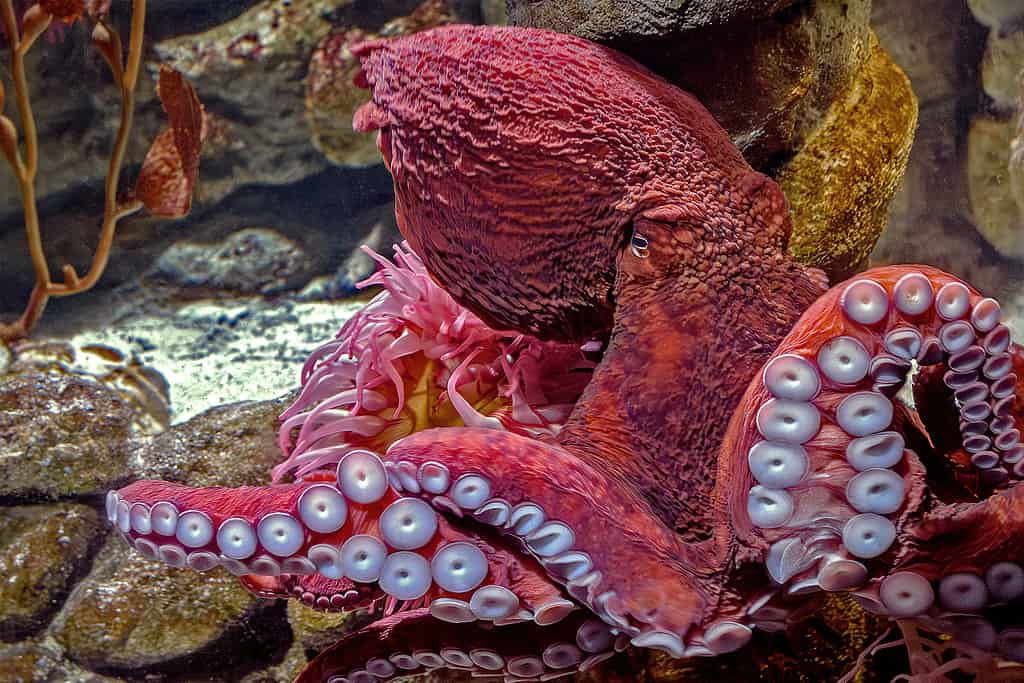
The giant Pacific octopus uses changes in its body colors to communicate with others of its kind.
©Christopher R Mazza/iStock via Getty Images
One of the most interesting animals you must visit at Mystic Aquarium is the giant Pacific octopus. Naturally found near the coasts of the U.S., Russia, and Japan, these incredible creatures change colors to communicate with one another. Weighing 30 pounds on average, most have at least a 14-foot arm span. Some of the largest individuals weigh over 500 pounds, with arms reaching up to 20 feet! They eat mostly shellfish and crustaceans but have been known to take down small sharks and even birds. The most amazing fact? These octopuses have nine brains — one central brain and eight smaller ones that control each arm!
#8 Sand Tiger Sharks
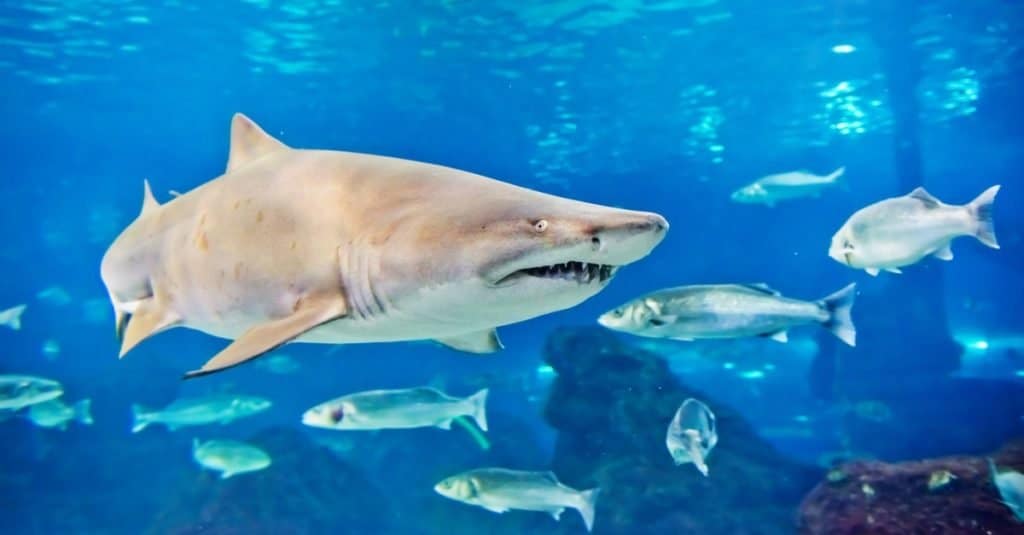
Sand
tiger
sharks are an endangered species because humans hunt them or they get accidentally caught in fishing nets (bycatch).
©Valeri Potapova/Shutterstock.com
Found swimming among the fish at Mystic Aquarium, these animals usually live along the coast in warm waters worldwide. Typical lengths range from 6 to 9 feet. Weighing up to 300 pounds, the sand tiger shark eats large fish, sting rays, and squids. Marked as endangered by IUCN, their low reproduction rate causes them difficulty in regaining population numbers.
#9 Nurse Sharks
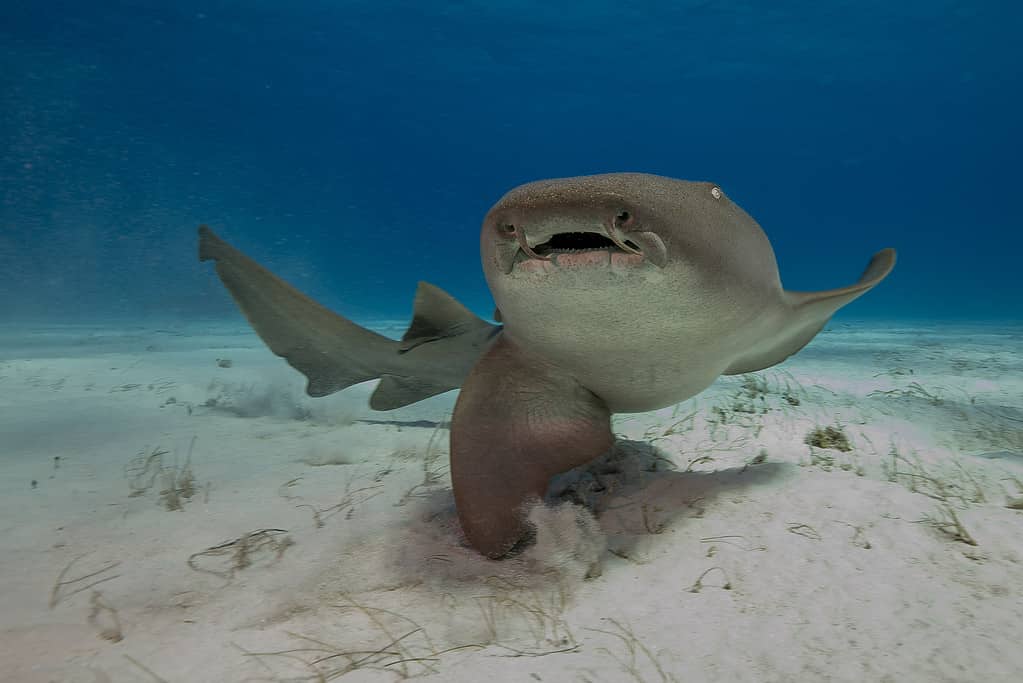
Nurse sharks
get their name from how they hunt, sifting through the sandy ocean bottom for crustaceans.
©Stevelaycock21 / CC BY-SA 4.0 – License
Larger than the sand tiger shark, the nurse shark reaches 10-14 feet in length and weighs up to 250 pounds. They’re frequently found off the coast of the Americas and Africa and prefer warm water. These sharks hunt at night, feeding on crustaceans like lobsters, crabs, and shrimp. They rest in groups on the ocean floor during the day, a rare phenomenon among sharks. ICUN lists them as vulnerable. Mystic Aquarium houses several of these astonishing animals.
#10 Zebra Sharks
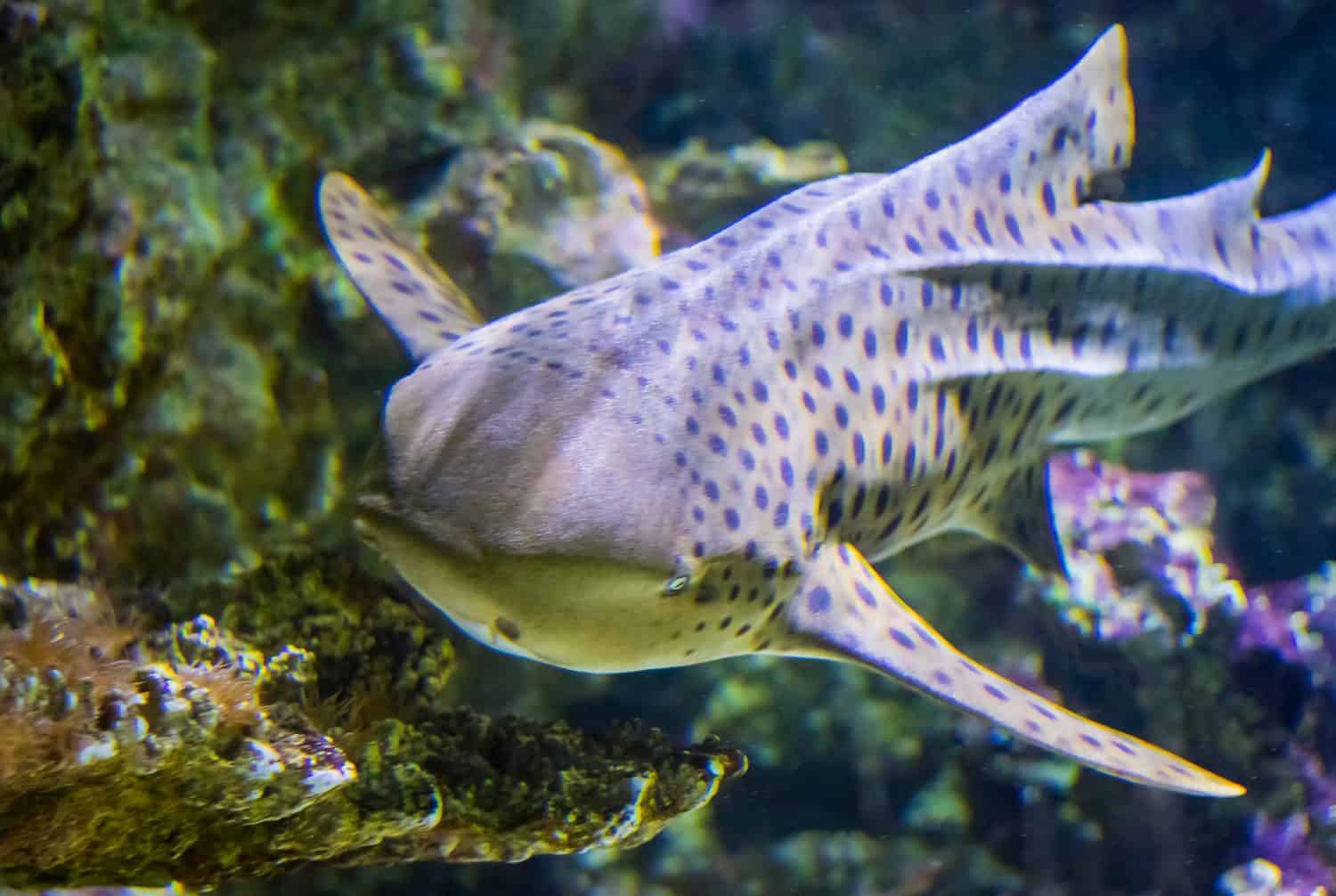
Mystic Aquarium keeps a less common variety of zebra shark (
Stegostoma varium).
©Wynian/Shutterstock.com
These zebra sharks normally inhabit the Indian and West Pacific Oceans. This smaller shark species usually reaches only 7-9 feet in length (though can reach up to 12 feet) and prefers living near coral reefs. They prey on similar animals as the nurse shark but also eat some fish. They are endangered according to IUCN. Furthermore, they are one of few shark species that can pump water over their gills, so they do not have to continuously swim to breathe. Mystic Aquarium actively participates in the Species Survival Plan for these animals, as well. They currently have one female that hatched from an egg in 2022. Hopefully, she will eventually breed.
The photo featured at the top of this post is © WoodysPhotos/Shutterstock.com
Thank you for reading! Have some feedback for us? Contact the AZ Animals editorial team.





